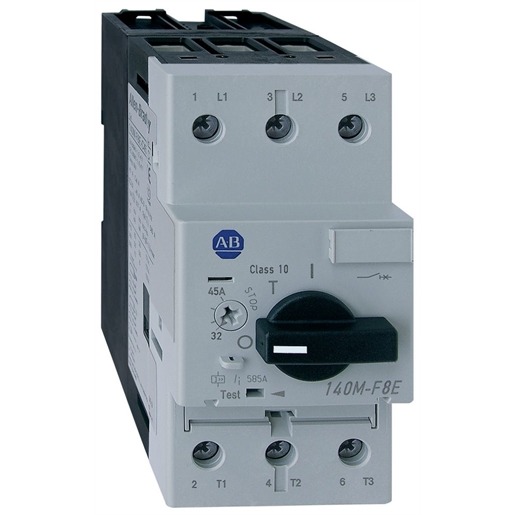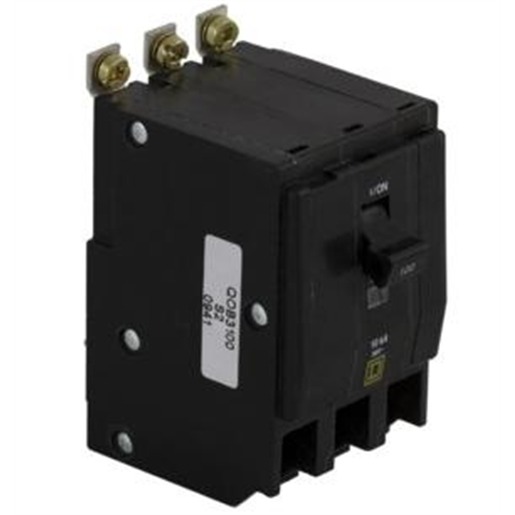Motor Protection Circuit Breakers (MPCB) and Motor Circuit Protector (MCP)
Motor Protection Circuit Breakers (MPCB)
This type of circuit breaker includes both overload protection (thermal or electronic) and fault protection (magnetic). The trip characteristics of an MPCB are specifically designed for the protection of motors, allowing the inrush current but preventing any over-current condition that exceeds it.
Motor Circuit Protector (MCP)
MCPs only offer magnetic protection against fault currents, and therefore their trip is instantaneous. To provide overload protection, it is necessary to complement them with an overload relay and a contactor.
The main advantage of MCPs is that their trip response can be fine-tuned according to the expected inrush current, which may vary according to the type of motor starter used
MPCB/MCP Providers
Allen-Bradley
Eaton
GE

Understanding Circuit Breaker Specifications
Circuit breakers come with a list of several specifications, and understanding them is vital in order to select the proper breaker for each application. The technical specifications most commonly found in miniature (MCB) and molded-case (MCCB) circuit breakers are the following
Rated Operational Voltage (Ue)
Self-Explanatory: The operating voltage which the circuit breaker is designed. A single breaker may be rated for several voltages, or may be compatible with both AC and DC voltages.
Rated Insulation Voltage (Ui)
This is the voltage at which the circuit breaker is tested under laboratory conditions. For safety reasons, this value is always higher than the rated voltage.
Rated Impulse-Withstand Voltage (Uimp)
Maximum peak voltage the circuit breaker can withstand without being damaged. The Uimp often has a value of several thousand volts.
Rated Current (In)
Maximum current the circuit breaker allows without tripping. Anything above this value will eventually cause it to trip. Low overcurrent levels trip the thermal protection in a few minutes, while drastic peaks in current (line fault, short circuit) cause an instant trip.
Service breaking capacity (Ics)
This is the largest fault current the circuit breaker can interrupt without suffering damage.
Ultimate breaking capacity (Icu)
Maximum fault current that the circuit breaker can interrupt. However, the unit is damaged permanently for all fault currents above the service breaking capacity.
Mechanical Life
Average number of times the circuit breaker handle can be operated manually before failure.
Electrical Life
Average number of times the circuit breaker can trip before failure.
Reasons Why Circuit Breakers Trip
Circuit breakers that trip frequently may seem like a nuisance, but it actually means they are doing their job properly – cutting off the electric supply when excessive current is detected. Most modern circuit breakers have two independent tripping mechanisms, and each is designed to respond to a different type of fault.
The thermal tripping mechanism disconnects the circuit breaker when its rated current is exceeded for a predetermined period of time. This tripping mechanism allows for short-duration overcurrent conditions, which are common in some applications; for example, electric motors may draw 5 to 8 times their rated current when they start, but only for a very short time.
On the other hand, the magnetic tripping mechanism has an instant response and is designed to clear high-current faults such as short circuits or ground faults. When these faults occur, they are always an issue and must be cleared as soon as possible. When you see circuit breakers labeled as type B, C or D, the letters indicate the threshold at which the magnetic tripping mechanism is activated.
A type B circuit breaker trips at 3 to 5 times rated current.
A type C circuit breaker trips at 5 to 10 times rated current.
A type D circuit breaker trips at 10 to 20 times rated current.
Thus, if a circuit breaker trips, there are two main possibilities: either a fault has occurred, or the circuit breaker is not adequate for the application at hand. This article will provide an overview of the main reasons why circuit breakers trip.

Electrical Circuit Overload – Top Reason Why Circuit Breakers Trip
Electrical Circuit Overload
Basically, an overload occurs when the current through a circuit breaker exceeds it rated value for longer than what is normal for the application, causing it to trip. For instance, if a 20-amp breaker experiences a current of 25 amps, it will likely trip in less than one minute. You can conclude that the breaker is tripping due to an overload when disconnection does not occur instantaneously (the thermal mechanism is acting, not the magnetic one)
When this happens, the solution may vary depending on specific conditions:
Check the rated current of the devices connected to the circuit breaker. If they are operating normally and the breaker is still being tripped, it was sized too small.
On the other hand, if any of the devices is drawing an abnormally high current, the issue lies in the device itself and not necessarily the circuit breaker.
Keep in mind that both situations may occur simultaneously: maybe one of the devices connected to the breaker panel is drawing a higher current than normal, but the breaker still trips even after the issue was fixed. Therefore, it is best to always start by checking the current being drawn by the appliances connected to circuit breakers.
SquareD Miniature Circuit Breaker (QO/QOB) Terminology
SquareD by Schneider Electric is one of the top brands of circuit breakers in the industry. This wiki post provides the meaning of the most common abbreviations found on the QO/QOB product line.
QO and QOB
These letters refer to the way in which the miniature circuit breaker is mounted on the panel.
QO = Plug-in (snaps in place, no bolted connection to the distribution board)
QOB = Bolt-on (Note the bolts attached to the breaker)
Some characteristics are shared by all breakers in the QO/QOB product line:
Thermal-magnetic protection = Works against both overload and fault currents, calibrated for an ambient temperature of 40°C.
Equipped with a visual trip indicator = QO/QOB circuit breakers have a small window where a red indicator appears when the unit has tripped. The handle remains in the central position between on and off.
Where can QO circuit breakers be used?
QO load centers
NQ & NQOD panelboards
OEM mounting bases
Speed-D® switchboard distribution panels
Where can QOB circuit breakers be used?
NQO & NQOD panelboards
Numerical Code
After the QO/QOB marking, Square D circuit breakers have a numerical code such as “115”, “230” and “3100”. Interpreting it is very simple:
The first number indicates the number of poles.
The following two or three digits indicate the current rating.
The three examples mentioned above would indicate:
115 = 1-pole, 15 Amps
230 = 2-pole, 30 Amps
3100 = 3-pole, 100 Amps
Additional Letter Codes – Special Applications
QO and QOB circuit breakers may have additional letter codes, which indicate the following special applications:
QO-HM / QOB-HM
High Magnetic – Designed for lighting applications with a high inrush current. Only available in 15A and 20A ratings.
QO-HID / QOB-HID
High Intensity Discharge – For use with HID lighting fixtures such as metal halide, high pressure sodium and mercury vapor. Similar to HM, but designed specifically for HID lighting applications.
QO / QOB Miniature Switch
Miniature Switch – No thermal-magnetic protection, exclusively for manual disconnection.
QOK / QOBK
Key-Operated – Manual operation is accomplished through a key instead of a handle. Only available in 10A to 30A ratings, 1-pole, 120 VAC, 10 kA.
QO-GFI / QOB-GFI Qwik-Gard ®
Ground-Fault Interrupter – Designed to offer ground-fault protection for humans, trips with any ground-fault current of 6mA or more.
QO-EPD / QOB-EPD
Equipment Protection Device – Designed to offer ground-fault protection for equipment, trips with ground-fault currents of 30 mA or more.
QO-SWN / QOB-SWN
Switch Neutral Circuit Breaker – Disconnects both grounded and ungrounded conductors in applications that require it, such as gas pump assemblies.
QOT
Tandem Circuit Breaker – Two separate circuit breakers occupy the same pole space. They are designed for loads that are light and non-continuous.
QO-PL / QOB-PL Powerlink ®
Remotely Operated – Can be switched remotely by control devices such as push buttons and PLCs.
QO-AFI / QOB-AFI
Arc-Fault Interrupter, Branch Feeder Type – Can detect an arc-fault in the branch circuit being protected, and trips accordingly.
QO-CAFI / QOB-CAFI
Arc-Fault Interrupter, Combination Type – Same as above, but also includes arc-fault protection for cord sets and power-supply cords.